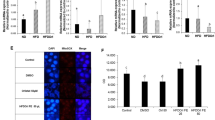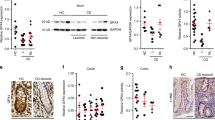Abstract
Oxidative challenge can compromise intestinal growth and death responses. This study examines the effect of chronic consumption of subtoxic levels of peroxidized lipids on intestinal redox balance and turnover and the effect of glutathione (GSH) supplementation. Male Sprague-Dawley rats were fed standard rat chow or 4% peroxidized menhaden oil chow (2–8 weeks). Intestinal GSH and glutathione disulfide (GSSG), GSH synthetic and redox enzymes as well as proliferative (ornithine decarboxylase, ODC) and apoptotic activities were evaluated. Chronic peroxide intake did not affect overall animal growth, but decreased intestinal GSH/GSSG ratio that directly correlated with decreased GSH and increased GSSG, and suppressed peak circadian ODC activities and postprandial mucosal apoptosis. Supplementation with GSH restored the mucosal GSH/GSSG ratio and abrogated the peroxide-induced suppression of intestinal cell turnover. Collectively, the results show that chronic lipid peroxide consumption induces intestinal GSH redox imbalance that interferes with regulation of enterocyte death and proliferation in vivo. These disruptive effects of lipid peroxides were reversed by GSH supplementation in accordance with the normalization of tissue GSH/GSSG redox balance.
Similar content being viewed by others
REFERENCES
Ames BN: Dietary carcinogens and anticarcinogens. Science 221:1256-1264, 1983
Parks DA, Bulkley GB, Granger DN: Role of oxygen-derived free radicals in digestive tract diseases. Surgery 94:415-422, 1983
Correa P, Strong JP, Johnson WD, Pizzolato P, Haenszel W: Atherosclerosis and polyps of the colon: Quantification of precursors of coronary heart disease and colon cancer. J. Chronic Dis 35:313-320, 1982
Carroll KK, Khor HT: Dietary fat in relation to tumorigenesis. Prog Biochem Pharmacol 10:308-353, 1975
Reddy BS: Dietary fat and colon cancer. In Experimental Colon Carcinogenesis. H Antrup, GM Williams (eds). Boca Raton, Florida, CRC Press, 1983, pp 225-239
Bull AW, Nigro ND, Golembieski WA, Crissman JD, Mamett LJ: In vivo stimulation of DNA synthesis and induction of ornithine decarboxylase in rat colon by fatty acid hydroperoxides, autoxidation products of unsaturated fatty acids. Cancer Res 44:4924-4928, 1984
Creamer B, Shorter RG, Bamforth J: The turnover and shedding of epithelial cells. Gut 2:110-118, 1961
Miller DL, Hanson W, Schedl HP, Osborne JW: Proliferation rate and transit time of mucosal cells in small intestine of the diabetic rat. Gastroenterology 73:1326-1332, 1977
Tutton PJM: Variations in crypt cell cycle time and mitotic time in the small intestine of the rat. Virchows Arch 13:68-78, 1973
Potten CS, Al-Barwari SE, Hume WJ, Searle J: Circadian rhythm of presumptive stem cells in three different epithelia of the mouse. Cell Tissue Kinet 10:557-568, 1977
Potten CS: The significance of spontaneous and induced apoptosis in the gastrointestinal tract of mice. Cancer Metastasis Rev 11:179-195, 1992
Iwakiri R, Gotoh Y, Noda T, Sugihara H, Fujimoto K, Fuseler J, Aw, TY: Programmed cell death in rat intestine: Effect of feeding and fasting. Scand J Gastroenterol 36:39-47, 2001
Gotoh Y, Noda T, Iwakiri R, Fujimoto K, Rhoads CA, Aw TY: Lipid peroxide-induced redox imbalance differentially mediates CaCo-2 cell proliferation and growth arrest. Cell Prolife 35:221-235, 2002
Noda T, Iwakiri R, Fujimoto K, Aw TY: Induction of mild intracellular redox imbalance inhibits proliferationof CaCo-2 cells. FASEB J 15:2131-2139, 2001
Wang TG, Gotoh Y, Jennings MH, Rhoads CA, Aw TY: Lipid hydroperoxide-induced apoptosis in human colonic CaCo-2 cells is associated with an early loss of cellular redox balance. FASEB J 14:1567-1576, 2000
Aw TY, Williams MW, Gray L: Absorption and lymphatic transport of peroxidized lipids by rat small intestine in vivo: role of mucosal GSH. Am J Physiol 262:G99-G106, 1992
Aw TY, Williams MW: Intestinal absorption and lymphatic transport of peroxidized lipids in rats: effect of exogenous GSH Am J Physiol 263:G665-G672, 1992
Aw TY: Biliary glutathione promotes the mucosal metabolism of luminal peroxidized lipids by rat small intestine in vivo. J Clin Invest 94:1218-1225, 1994
Bruno E, Pettt E, Beljean-Leymarle M, Huynh MS, Nouvelat A: Specific susceptibility of docosahexaenoic acids and eicosapentaenoic acids to peroxidation in aqueous solution. Lipids 24:970-975, 1989
Buege JA, Aust SD: Microsomal lipid peroxidation. Methods Enzymol 52:302-310, 1978
Cepinskas G, Kvietys PR, Aw TY: The cytotoxicity of peroxidized omega-3 lipids on cultured human epithelial cells is related to the development of cellular GSH-dependent antioxidant systems. Gastroenterology 107:80-86, 1994
Burton K: A study of the conditions and mechanism of the diphenylamine reactions for the colorimetric estimation of deoxyribonucleic acid. Biochem. J 62:315-323, 1956
Tabata K, Johnson LR: Mechanism of induction of mucosal ornithine decarboxylase by food. AmJ Physiol 251:G370-G374, 1986
Reed DJ, Babson JR, Beatty PW, Brodie AE, EllisWW, Porter DW: High-performance liquid chromatography analysis of nanomole levels of glutathione, glutathione disulfide, and related thiols and disul-fides. Anal Biochem 106:55-62, 1980
Gavrielli Y, Sherman Y, Ben-Sasson SA: Identification of programmed cell death via specific labeling of nuclear DNA fragmentation. J Cell Biol 119:493-501, 1992
Luk GD, Marton LJ, Baylin SB: Ornithine Decarboxylase is important in intestinal mucosal maturation and recovery from injury in rats. Science 210:195-198, 1980
Tabor CW, Tabor H: Polyamines. Ann Rev Biochem 53:749-790, 1984
Pegg AE, McCann PP: Polyamine metabolism and function. Am J Physiol 243:C212-221, 1982
Fujimoto M, Kanaya A, Nakaboku Y, Hagihira H: Circadian rhythm in the ornithine decarboxylase activity of rat small intestine. J Biochem 83:237-242, 1978
Sepulveda FV, Burton KA, Clarkson GM, Syme G: Cell differentiation and L-ornithine decarboxylase activity in the small intestine of rats fed lowand high protein diets. Biochem Biophys Acta 716:439-442, 1982
Tabata K, Johnson LR: Ornithine decarboxylase and mucosal growth in response to feeding. Am J Physiol 251:G270-G274, 1986
Fujimoto K, Granger DN, Johnson LR, Price VH, Sakata T, Tso P: Circadian rhythm of ornithine decarboxylase activity in small intestine of fasted rats. Exp Biol Med 200:409-413, 1992
Hagen TM, Aw TY, Jones DP: Glutathione uptake and protection against oxidative injury in isolated kidney cells. Kidney Int 34:74-81, 1988
Lash LH, Hagen TM, Jones DP: Exogenous glutathione protects intestinal sepithelial cells from oxidative injury. Proc Natl Acad Sci USA 83:4641-4645, 1986
Hagen TM, Brown LA, Jones DP: Protection against paraquatinduced injury by exogenous GSH in pulmonary alveolar type ll cells. Biochem Pharmacol 35:4537-4542, 1986
Andreoli SP, Mallett CP, Bergstein JM: Role of glutathione in protecting endothelial cells against hydrogen peroxide oxidant injury. J Lab Clin Med 108:190-198, 1986
Iwanaga T, Han H, Adachi K, Fujita T: A novel mechanism for disposing of effete epithelial cells in the small intestine of guinea pigs. Gastroenterology 105:1089-1097, 1993
Hall PA, Coates PJ, Ansari B, Hopwood D: Regulation of cell number in the mammalian gastrointestinal tract: the importance of apoptosis. J Cell Sci 107:3569-3577, 1994
Aw TY: Molecular and cellular responses to oxidative stress and changes in oxidation-reduction imbalance in the intestine. Am J Clin Nutr 70:557-565, 1999
Flores SC, McCord JM: Redox regulation by the HIV-1 Tat transcriptional factor. In Oxidative Stress and the Molecular Biology of Antioxidant Defenses. JG Scandalos, (ed). Cold Spring Harbor, New York, Cold Spring Harbor Laboratory Press, 1997, pp 117-138
Tanaka J, Fujimoto K, Sakata T, Fujimoto T, Tsunada S, Iwakiri R, Yamaguchi M, Okabe Y, Yoshimatsu H: Effect of vagotomy on ornithine decarboxylase activity in rat duodenal mucosa. AmJ Physiol 265:G1016-G1020, 1993
Author information
Authors and Affiliations
Rights and permissions
About this article
Cite this article
Tsunada, S., Iwakiri, R., Noda, T. et al. Chronic Exposure to Subtoxic Levels of Peroxidized Lipids Suppresses Mucosal Cell Turnover in Rat Small Intestine and Reversal by Glutathione. Dig Dis Sci 48, 210–222 (2003). https://doi.org/10.1023/A:1021775524062
Issue Date:
DOI: https://doi.org/10.1023/A:1021775524062




